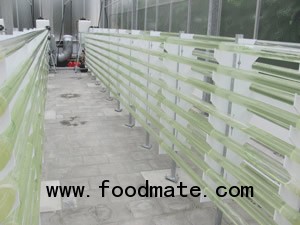
The cultivation of algae is of worldwide interest. Algae can be used as a raw material for food, animal feed, fuel and chemicals. The cultivation under glass has advantages compared to algae reactors outside. It is simpler to maintain the temperature of the cultivation, because the glasshouse works as a large collector of sunlight. In addition there are no problems with frost in a glasshouse. Besides in a glasshouse the infrastructure (heat, CO2, water, fertilizer) for algae cultivation is present.
From the calculations on models by Wageningen UR Glastuinbouw it appears that the cultivation of algae from the more expensive segment offers perspectives for glasshouse horticulture. The experiment in first instance concentrated on the cultivation technique. For that six reactors were built in one of the research departments in Bleiswijk. One algae reactor consists of transparent PVC tubes, through which the algae culture moves. The tube circuit of one reactor has eight layers. Various cultivation factors are diversified in the research.
The experiments are to supply insight in the optimum conditions for cultivation. The research is being attended to by a commission of a number of growers, of whom some already have experience in the cultivation of algae.





